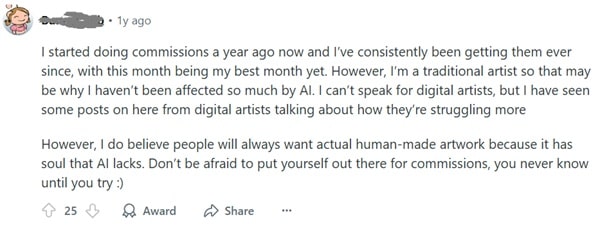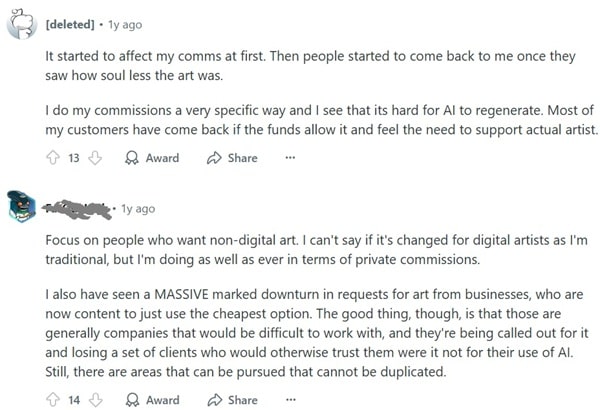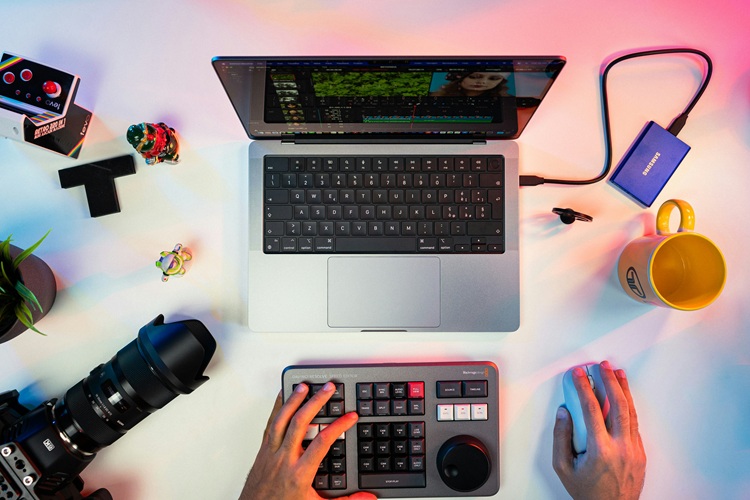Figuring out commission pricing can feel overwhelming, especially when you’re just starting out and trying to set fair beginner art commission prices. Should you charge by the hour, by the piece, or just go with your gut? In this post, we’ll break it all down.
We’ll talk about how artists set prices, how to charge as a freelance artist, and how to actually calculate a commission price that makes sense. Plus, we’ll touch on how AI is shaking things up in the art world and what that means for commission pricing. By the end, you’ll know exactly what to avoid – and what to do – so you don’t undercharge or sell yourself short.
Read next: 25 Best Websites for Art Commissions to Boost Your Income

We may get a commission at no cost to you if you purchase through our links. You can read our disclosure at any time!
How do artists set prices?
Artists set prices by balancing creativity with strategy. It’s not just about pulling a number out of thin air – it’s about knowing your worth and backing it up with a clear method. Most artists start by calculating their base hourly rate, which should cover living expenses, business costs, and taxes. From there, they multiply that rate by the estimated time a project will take.
But time isn’t the only factor. Materials, complexity, revisions, and licensing rights all add value to a commission. For example, a quick sketch and a detailed, full-color digital painting might take the same canvas size but require drastically different pricing. Artists also look at demand – if commissions are filling up quickly, it’s often a signal to raise rates.
Many use tiered pricing, offering basic, standard, and premium packages so clients can choose based on budget and scope. Others stick to flat rates for simplicity. The key is consistency: when your pricing feels structured and transparent, clients are more likely to respect it. Ultimately, setting prices is part math, part confidence, and part market awareness. Get those three right, and your rates will both attract clients and sustain your art career.
How has AI affected art commissions?
AI has definitely changed the landscape of art commissions. With tools that can generate images in seconds, some clients turn to AI instead of hiring an artist. That can feel discouraging, especially when you’ve spent years building your skills. But here’s the truth: AI can’t replace the personal touch, creativity, and emotional connection that comes from working with a real artist.
In fact, many artists are using AI as a tool rather than a threat. Some incorporate it into their workflow to speed up brainstorming, generate references, or refine ideas – then finish the artwork by hand or digitally with their own style. Others lean into the value of authenticity, marketing their commissions as unique, human-made pieces that AI simply can’t replicate.
The demand for personalized, custom commissions hasn’t disappeared – it’s just shifting. People still want art that feels meaningful, crafted with intention, and tailored to them. By positioning your work as original, high-quality, and story-driven, you can stand out even more in a world where AI outputs often feel generic. In short: AI is here, but it doesn’t erase the need for artists – it highlights why your creative voice matters.
Digital vs Manual: How AI affects digital artists vs traditional artists
AI has had a much bigger impact on digital artists than traditional ones. Since AI tools create digital outputs instantly, clients looking for “cheap and fast” visuals often bypass hiring a digital artist. This shift can feel frustrating – especially if you’re competing against quick, low-cost alternatives.
That said, digital artists still have a major advantage: adaptability. Unlike AI, you bring intentional design choices, personality, and collaboration to the table. You can adjust to feedback, capture subtle emotions, and create original styles – things AI struggles to replicate. Many clients still value working with a person, not just downloading a file.
Traditional artists, on the other hand, face less direct competition. AI can generate images, but it can’t produce physical canvases, handmade textures, or tangible artwork. In fact, some collectors are turning back to traditional art precisely because it feels more “real” in a digital-heavy world.
As an example, see the real experiences of actual commission artists navigating this currently on the subreddit r/artbusiness/


The bottom line? Digital artists may need to market themselves differently – highlighting originality, customization, and authenticity. Traditional artists can emphasize the irreplaceable nature of handmade work. In both cases, AI isn’t the end of commissions – it’s just a push to showcase why human art has lasting value.
11 Commission Pricing Mistakes Artists Must Avoid in 2025
Even the most talented artists can lose money – or clients -if they make the wrong moves when it comes to commission pricing. Here are 11 common mistakes that can hurt your income, plus tips on how to avoid them.
1. Guessing Your Rates Instead of Calculating Them
Too many artists pick random numbers for their artwork commission prices without breaking down their actual costs. This usually means they end up undercharging. To avoid this, calculate:
- Hourly rate (based on your living costs, business expenses, and desired income)
- Materials and tools
- Admin time (emails, contracts, revisions)
Knowing your numbers ensures your art commission cost actually sustains you.
2. Ignoring Market Research
While your work is unique, you still need to know the average art commission price in your niche. Check platforms like Etsy, Fiverr, and DeviantArt to see what others charge. Compare beginner art commissions prices with established artist rates so you can position yourself competitively without undervaluing your time.
Related: How to market yourself as a creative: Self-marketing for artists
3. Offering Endless Revisions for Free
Unlimited edits quickly eat into your profits. Always specify how many revisions are included in your quote and charge extra for additional changes. A good rule is 2–3 minor revisions included, with major edits billed separately. Clear boundaries keep your workflow manageable and your commission pricing fair.
4. Not Having a Professional Portfolio with Terms & Prices
Clients hesitate when your work isn’t presented clearly. A professional portfolio shows your style, credibility, and artwork commission prices upfront. Include:
- Examples of past commissions
- A price list or pricing guide
- Terms of service (revisions, timelines, licensing rights)
For hosting, you can use DreamHost (professional websites), Tumblr (community-driven galleries), or Ko-fi (easy shop setup). Whatever you choose, make sure clients see your terms before they buy.

Affordable Hosting with DreamHost
Get fast and reliable web hosting starting at just $35.40/year. DreamHost includes a FREE domain name, FREE privacy protection, unlimited email @ your domain, and powerful hosting for blogs and online stores.
Get DreamHost Now5. Forgetting to Adjust for AI Competition
Although we’ve already covered that AI won’t replace artists, it has created new competition – especially for digital creators. This affects average digital art commission prices more than traditional artwork.
Artists now face two main choices:
- Charge higher prices → fewer clients, but higher income per project.
- Charge lower prices → more accessible to buyers who might otherwise use free AI tools.
Neither path is “wrong.” The key is to adjust your commission pricing strategy to stay profitable without undervaluing your work.
6. Using the Same Rate for Every Project
Not all projects are created equal. A simple character sketch shouldn’t cost the same as a detailed A3 portrait. Many artists use tiered artwork commission prices (basic, standard, premium) to reflect complexity. This makes commission pricing clearer for clients while helping you earn fairly for bigger projects.
7. Forgetting to Charge for Licensing and Usage Rights
The average artist commission price should always reflect how the art will be used. Personal use? Lower fee. Commercial use (ads, merch, games)? Higher fee. By ignoring licensing, you risk losing out on serious income while clients profit from your work. Always ask about intended use before quoting.
8. Not Accounting for Time Beyond Drawing
Art commission cost isn’t just drawing – it’s emailing, drafting contracts, creating invoices, and handling admin. Forgetting to include this “hidden time” means your beginner art commissions prices will feel unsustainable. Build admin hours into your base rate so you’re actually paid for the full effort behind each commission.
9. Underpricing Out of Fear
A lot of beginners think low art commission prices will attract clients. While that might land a few jobs, it often sets the expectation that your work is “cheap.” Over time, it becomes harder to raise your rates. Instead, set your prices confidently and market the value behind your work.
10. Overcomplicating Your Price List
Clients get overwhelmed if your commission pricing looks like a math equation. Keep it simple. Offer 3–4 clear packages (e.g., sketch, colored illustration, full scene, premium project). A structured list makes it easier for clients to pick what fits their budget and boosts your average art commission price.
11. Not Reviewing and Raising Prices Over Time
If your skills improve but your artwork commission prices stay the same, you’re undercutting yourself. Review your rates at least once a year. Compare against the average artist commission price in your niche and adjust. Clients expect price increases over time – it signals growth, professionalism, and higher demand.
✨ Pro Tip: Commission pricing isn’t static – it evolves with your skills, your demand, and the market. By avoiding these mistakes, you’ll ensure your rates are fair to both you and your clients.
How to charge as a freelance artist?
Charging as a freelance artist is more than picking a number – it’s a combination of strategy, confidence, and clear communication. Start by understanding your costs: living expenses, materials, software subscriptions, and taxes. Then, calculate a realistic hourly or per-project rate that covers all of these while leaving room for profit.
Decide whether you’ll quote per hour or per project. Hourly rates work well for undefined or evolving projects, while fixed project rates give clients certainty and can save you negotiation headaches. Always account for revisions, administrative work, and licensing.
You can also create tiered packages: basic, standard, and premium, so clients can select based on budget and complexity. This helps communicate value and sets expectations upfront. Finally, don’t forget the soft skills: explaining your pricing confidently, documenting terms, and being professional with contracts make clients more likely to respect your rates. Freelance commission pricing is about balancing fair pay with client clarity.
What are three basic pricing strategies?
Artists often use three main pricing strategies to set their artwork commission pricing:
- Cost-plus pricing – Calculate all your costs (materials, tools, time, overhead) and add a profit margin. This ensures every commission is profitable.
- Market-based pricing – Research the average artist commission price in your niche and adjust your rates to stay competitive while reflecting your skill level.
- Value-based pricing – Price according to the perceived value of your work to the client, not just your time. For example, a custom digital portrait for commercial use could command higher rates than a personal sketch, even if both take the same hours.
Many artists combine strategies. For example, you might start with cost-plus to ensure a floor rate, then adjust upward for market demand or the unique value you provide. Using clear strategies helps avoid undercharging and builds a consistent, sustainable freelance income.
How do you calculate commission pricing?

Calculating commission price is both art and math. Begin by estimating the time required to complete the piece. Include prep, research, and any revisions. Multiply hours by your hourly rate to set a base figure.
Next, factor in materials and overhead, like paper, software, or subscription tools. Don’t forget administrative time – emails, contracts, and invoicing all count toward your workload.
Adjust your number based on project complexity and licensing. If a client wants exclusive rights or commercial usage, increase the rate accordingly. You can also use tiered pricing:
- Basic – Minimal complexity, personal use, fewer revisions
- Standard – More detailed, multiple revisions, limited commercial rights
- Premium – Full detail, unlimited revisions, full commercial rights
Finally, compare your result to the average art commission price for similar work. If it’s too low, adjust to avoid undercharging. Clear calculations make your commission pricing fair, consistent, and professional for both you and your clients.
What’s a good hourly rate for an artist?
How much do artists charge per hour?
Determining a good hourly rate depends on your experience, niche, and location. Beginners often start around $20–$40/hour, intermediate artists $40–$80/hour, and advanced or specialized artists $80–$150+/hour. These rates should cover living costs, materials, taxes, and business overhead.
To set your hourly rate:
- Calculate your annual expenses (rent, utilities, subscriptions, materials)
- Estimate your billable hours per month realistically
- Add a profit margin for savings and growth
Remember, the “good” rate isn’t just about being competitive – it’s about sustainability. If your rate is too low, you risk burnout and undervaluing your work. If it’s too high, some clients may hesitate, but many will recognize the value of your experience and professionalism. Keep in mind that average art commission prices often reflect these hourly calculations when converted into per-project quotes.
Quick commission pricing cheat
Commission Pricing Cheat Sheet
Calculate Base Rate
Estimate hours × your hourly rate. Include time for drawing, research, and revisions. This gives a solid starting point for your commission pricing.
Add Materials & Overhead
Include supplies, software, subscriptions, and administrative time. These costs ensure your art commission cost is sustainable.
Factor Complexity & Licensing
Adjust prices for project difficulty, level of detail, and intended usage. Personal use vs. commercial rights can drastically affect the rate.
Tiered Packages
Create basic, standard, and premium options. Each tier scales in complexity, revisions, and rights to make pricing clear and flexible for clients.
Check Market Rates
Compare your pricing to average art commission prices, beginner art commissions prices, and average digital art commissions prices in your niche.
Adjust & Review
Regularly revisit your rates based on skill growth, demand, and AI trends. Update your commission pricing to remain profitable and competitive.
How to calculate artist fees?
Calculating artist fees starts with understanding all the costs and time involved in a project. Begin by estimating how many hours the commission will take. Multiply that by your hourly rate to set a base fee.
Next, add:
- Materials and supplies – paint, canvas, digital tools, software subscriptions
- Administrative tasks – emails, contracts, invoices, and revisions
- Licensing or usage rights – personal vs. commercial use
For larger or more complex projects, consider offering tiered pricing: basic, standard, and premium. Each tier can differ in detail, revisions, and usage rights.
Finally, cross-check your total against the average art commission price in your niche, including average digital art commission prices or beginner art commission prices if relevant. This ensures your fees are competitive but still profitable. Accurate calculations not only protect your income but also make your commission pricing professional and transparent for clients.
How much does a freelance artist make?
Freelance artist income varies depending on experience, niche, and client load. Beginners may earn a few hundred dollars per month, while intermediate artists can make $2,000–$5,000 monthly. Established professionals with commercial clients or high-demand styles can earn $6,000–$10,000+ monthly, or even six figures annually.
Key factors affecting income include:
- Number of projects per month
- Average artist commission price and art commission prices
- Complexity and size of commissions
- Licensing fees for commercial use
- Efficiency in workflow and client management
Freelancers who plan their schedule, track hours, and adjust rates for AI competition or market demand tend to have steadier income. Understanding these variables helps you set realistic expectations and achieve sustainable earnings.
Art commission payment methods
Getting paid smoothly is crucial for freelance success. Common payment options include:
- PayPal – simple, widely used, and supports international clients
- Stripe or credit cards – professional and secure
- Bank transfers – reliable for large or domestic transactions
- Platforms like Ko-fi or Patreon – ideal for small commissions or recurring support
Always request a deposit upfront (commonly 30–50%) before starting work. Clearly define payment milestones, due dates, and revision policies in a contract. Offering multiple payment methods makes clients more comfortable and reinforces your professionalism. Clear payment practices also help justify your art commission cost, average art commission price, and beginner art commissions prices, ensuring both parties feel secure and respected.
FAQs
Commission Pricing FAQ
What is a commission price?
It’s the fee for a custom artwork or design, based on time, skill, complexity, materials, revisions, overhead, and licensed rights—quoted as a fixed project price or hourly rate.
What is a commission based pricing strategy?
You price per project. Estimate hours, materials, complexity, and rights, then present clear tiers or a fixed quote so clients understand scope, deliverables, and cost upfront.
What is the rule of 3 in pricing?
Offer three tiers—basic, standard, premium. Increase scope, revisions, and licensing with each tier. Most clients choose the middle, boosting clarity and average order value.
What’s a good hourly rate for an artist?
Build from costs: (living + business + taxes + savings) ÷ billable hours. Rough guide: beginners $20–$40, intermediate $40–$80, advanced $80–$150+. Adjust for demand and deadlines.
What is a reasonable freelance rate?
Anything that’s profitable and market-aligned. Use your floor rate and add profit. Many freelancers land between $40–$120+/hour; quote per project when scope is defined.
How do I charge for a design?
Price by project: hours × rate + materials + admin + revisions + licensing. Include rush, kill, and out-of-scope fees. Present three packages for easy comparison.
How much to charge for an A3 drawing?
Calculate hours × rate, then add materials and revisions. Typical A3 ranges $120–$600+, depending on detail and style. Charge extra for commercial usage rights.
How much can I sell my paintings for?
Use hours × rate or size × rate per sq. inch, plus materials, framing, and gallery commission. Stay consistent and raise prices as demand and sales grow.
Final thoughts
Setting fair commission pricing is one of the most important steps in building a sustainable art career. From calculating your hourly rate and factoring in materials to offering tiered packages and adjusting for AI competition, every choice affects your income and professionalism. Avoid common mistakes, clearly communicate your fees, and stay consistent with your pricing strategy.
Remember, your artwork has value, and clients are willing to pay for quality, originality, and reliability.
Start tracking your projects, refine your rates regularly, and experiment with packages that match client needs. Over time, this approach will attract the right clients, increase your average commissions, and give you a steady, sustainable freelance income. Your skills, time, and creativity are worth it – so price them accordingly and protect your artistic business.






